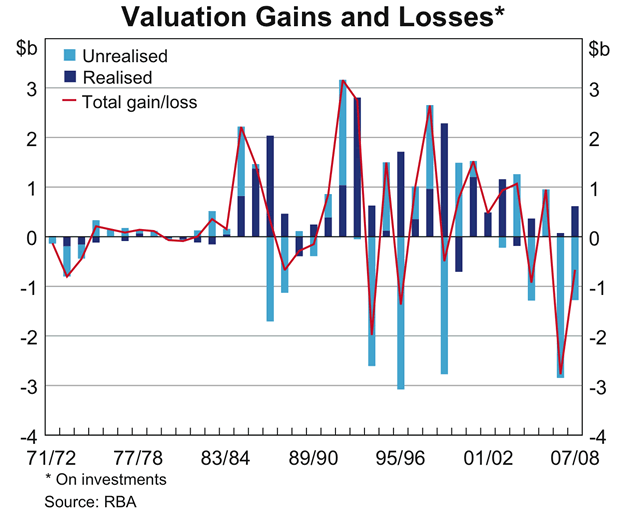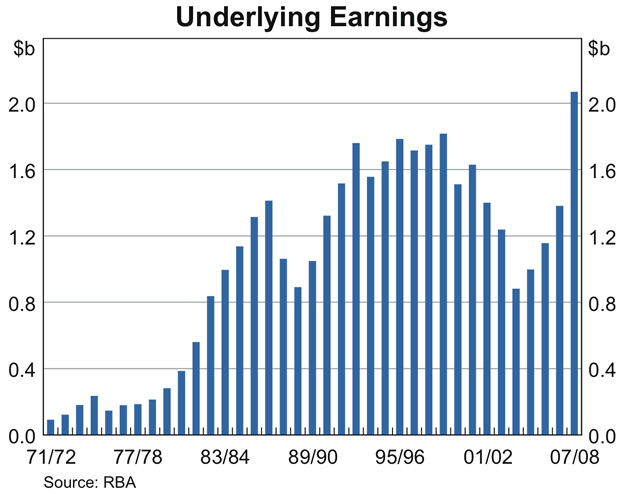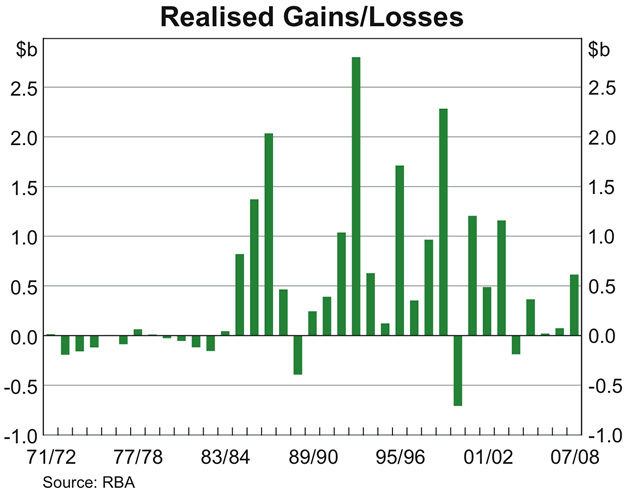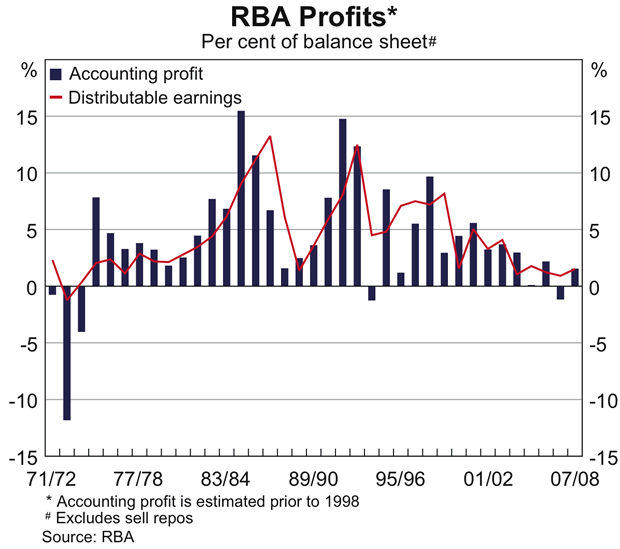Reserve Bank of Australia Annual Report – 2008 Earnings and Distribution
The Reserve Bank holds assets, amounting to about $100 billion at 30 June 2008, primarily to conduct operations in financial markets in pursuit of its monetary policy objectives. These financial assets include Australia's foreign exchange reserves and a portfolio of domestic securities to carry out liquidity management operations in Australia. The counterpart liabilities are composed of banknotes on issue, deposits of the Australian Government and other customers, and capital and reserves. No interest is payable on about half of these liabilities, namely banknotes and capital and reserves, whereas almost all of the Reserve Bank's assets earn interest. Consequently, its net interest income is sizeable. Net interest income, plus banking fees and rents less non-interest costs, are regarded as the Bank's underlying earnings. This is a relatively predictable and stable component of the Reserve Bank's profits, typically moving in line with the cycle in interest rates and the size of the balance sheet.
Since the Reserve Bank's assets are predominantly held in the form of highly rated domestic and foreign securities, valuation gains and losses that occur as the market prices of these assets fluctuate also affect profits. Valuation gains occur when bond yields fall (prices rise) or the exchange rate depreciates; losses occur when bond yields rise or the exchange rate appreciates. Gains or losses are realised when the underlying assets are sold in the course of operations to implement monetary policy or in managing foreign exchange reserves; they otherwise remain unrealised.
Since the Reserve Bank holds its assets for policy purposes, it has limited scope to manage the market risks it faces and, consequently, valuation gains and losses are both unpredictable and volatile. Valuation losses cannot be avoided in years in which there is either an appreciation of the exchange rate or rise in bond yields. The rise in the exchange rate of about 4 per cent in 2007/08 (based on a measure weighted by the currencies in which Australia's foreign exchange reserves are invested) led to valuation losses during the year. The unrealised valuation loss was smaller than in the previous year, when the reserves-weighted exchange rate rose by 12 per cent, but, for reasons discussed below, the impact on the dividend payable to the Australian Government is larger in the latest year.

The Reserve Bank's accounting profit is measured in accordance with Australian equivalents to International Financial Reporting Standards (AIFRS) and includes earnings from all sources (i.e. underlying earnings plus realised and unrealised valuation gains and losses). The distribution of profits is governed by section 30 of the Reserve Bank Act 1959, which determines, in effect, that underlying earnings and realised gains or losses are to be made available for distribution. By contrast, unrealised gains are not distributed but are transferred to the Unrealised Profits Reserve, where they remain available either to absorb future valuation losses or to be realised if the underlying assets are eventually sold. This legislative framework is designed to ensure that the Reserve Bank's capacity to absorb valuation losses, when they occur, is not eroded by the distribution of earlier unrealised gains.
While unrealised gains are transferred to the Unrealised Profits Reserve, the treatment of unrealised losses depends on the size of the loss and the balance held in this reserve. When unrealised losses are smaller than the balance of the reserve, they are absorbed by it (in other words, they are effectively offset against previously accumulated net unrealised gains). However, in years in which the unrealised loss exceeds the balance of this reserve, the amount by which the loss exceeds this balance is charged against other sources of income to restore the balance of the reserve to nil, consistent with accounting principles and sound central banking practice. Such a charge has the effect of reducing earnings available for distribution pari passu.
As the Unrealised Profits Reserve had been fully depleted in the previous year, all of the unrealised losses recorded in 2007/08 were charged against the other sources of the Reserve Bank's earnings, thereby reducing the dividend payable commensurately.
Earnings Available for Distribution
Earnings available for distribution were $1,403 million in 2007/08, compared with $1,085 million in 2006/07. The various components of earnings available for distribution in 2007/08 were as follows:
(i) Underlying earnings were $2,068 million, about $690 million more than last year, and higher than in any previous year. This increase reflects higher domestic interest rates, combined with the Reserve Bank holding more higher-yielding domestic assets (compared with foreign assets) as its market operations were more heavily concentrated in A$ securities in the latest year than in the recent past. The rise in underlying earnings was tempered by declining interest rates in the United States and the appreciation of the Australian dollar exchange rate, which tended to reduce the A$ value of interest earnings on foreign securities.
(ii) Realised gains of $614 million, comprising:
- gains of $485 million on foreign securities. These gains were realised in the normal course of managing foreign reserves over the first three quarters of the year as bond yields fell and securities were sold at higher prices than they had been purchased. Some losses were realised in the June quarter as bond yields rose;
- gains of $138 million from sales of foreign exchange; and
- losses of $9 million on domestic securities.
(iii) A charge against other sources of income for the unrealised valuation loss of $1,279 million, virtually all of which is due to the net appreciation of the exchange rate. The effect of this charge is to restore the unrealised profits reserve to nil on balance date. Charges of this kind have been made about one year in four, on average, over the past couple of decades.


While the unrealised valuation loss on the Reserve Bank's investments was smaller in 2007/08 than in 2006/07, the latest loss had a larger impact on earnings available for distribution because in the previous year the starting balance of about $2.5 billion in the Unrealised Profits Reserve absorbed most of the earlier unrealised loss. With a ‘nil’ balance in this reserve at the start of the latest year, all of the unrealised loss had the effect of reducing distributable earnings.
Earnings over a longer period are shown in the table below.
Reserves and Dividend
The Reserve Bank maintains a general reserve, the Reserve Bank Reserve Fund (RBRF), to provide for events that are contingent and non-foreseeable, including to cover losses from exceptionally large falls in the market value of its holdings of domestic and foreign securities that cannot be absorbed by its other reserves. This reserve also provides for losses that might arise from other business and operational risks, including fraud, to which the Reserve Bank is exposed. The RBRF has been funded over the years by transfers from earnings available for distribution and is essentially capital.
Under section 30 of the Reserve Bank Act 1959, transfers to the RBRF (from distributable earnings) are determined by the Treasurer after consultation with the Reserve Bank Board. The Act requires that the balance of distributable earnings after any such transfer be paid as a dividend to the Australian Government, the Reserve Bank's owner. The Board regarded the balance of $6,286 million in the RBRF at 30 June 2008 as satisfactory and did not seek a transfer to this Fund. Consequently, all of the earnings available for distribution in 2007/08, a sum of $1,403 million, was paid as a dividend to the Australian Government in August 2008.
The Reserve Bank also maintains a number of other financial reserves. As outlined above, in accordance with the Reserve Bank Act, unrealised gains are not available to be distributed but are transferred to the Unrealised Profits Reserve. As discussed, the charge made against other sources of income for unrealised losses in 2007/08 restored the balance of this reserve to nil as at 30 June 2008, the same as in the previous year.
| Underlying earnings | Realised gains and losses | Unrealised losses charged to other sources of income | Earnings available for distribution | |
|---|---|---|---|---|
| 1986/87 | 1,412 | 2,035 | – | 3,447 |
| 1987/88 | 1,062 | 464 | – | 1,526 |
| 1988/89 | 891 | −394 | −80 | 417 |
| 1989/90 | 1,049 | 245 | −199 | 1,095 |
| 1990/91 | 1,322 | 391 | – | 1,713 |
| 1991/92 | 1,516 | 1,038 | – | 2,554 |
| 1992/93 | 1,760 | 2,803 | – | 4,563 |
| 1993/94 | 1,556 | 628 | −676 | 1,508 |
| 1994/95 | 1,649 | 123 | – | 1,772 |
| 1995/96 | 1,784 | 1,712 | −1,010 | 2,486 |
| 1996/97 | 1,715 | 1,990 | – | 3,705 |
| 1997/98 | 1,750 | 1,524 | – | 3,274 |
| 1998/99 | 1,816 | 2,284 | −424 | 3,676 |
| 1999/00 | 1,511 | −708 | – | 803 |
| 2000/01 | 1,629 | 1,205 | – | 2,834 |
| 2001/02 | 1,400 | 489 | – | 1,889 |
| 2002/03 | 1,238 | 1,159 | – | 2,397 |
| 2003/04 | 882 | −188 | – | 694 |
| 2004/05 | 997 | 366 | – | 1,363 |
| 2005/06 | 1,156 | 21 | – | 1,177 |
| 2006/07 | 1,381 | 75 | −371 | 1,085 |
| 2007/08 | 2,068 | 614 | −1,279 | 1,403 |
Asset revaluation reserves are maintained for non-traded assets such as gold holdings, shares in the BIS and property, plant and equipment. The balances in these reserves represent the difference between the market value of these assets and the cost at which they were acquired. Balances in these reserves at 30 June 2008 stood at $2,807 million, an increase of $568 million from a year earlier, mainly reflecting an increase in the Australian dollar value of the Reserve Bank's holdings of gold.
Accounting Profit
The Reserve Bank's financial statements (and accompanying Notes to the Accounts) are prepared in accordance with AIFRS, consistent with the Finance Minister's Orders issued under the Commonwealth Authorities and Companies Act 1997. As noted, accounting profit is measured as profit from all sources.
Accounting profit in 2007/08 was $1,430 million, compared with an accounting loss of $1,393 million the previous year. The move from loss to profit reflects a smaller unrealised loss in 2007/08 and larger underlying earnings and realised gains.
| Earnings available for distribution |
Transfers to reserves |
Payments to the Australian Government | |||||
|---|---|---|---|---|---|---|---|
| Balance available from current year's profit |
Interim payment from current year's profit |
Payment from previous year's profit | Payment delayed from previous year | Total payment | |||
| 1990/91 | 1,713 | 210 | 1,503 | 400 | 275 | – | 675 |
| 1991/92 | 2,554 | 200 | 2,354 | 400 | 1,103 | – | 1,503 |
| 1992/93 | 4,563 | 750 | 3,813 | 600 | 1,954 | – | 2,554 |
| 1993/94 | 1,508 | – | 1,508 | – | 3,213 | – | 3,213 |
| 1994/95 | 1,772 | – | 1,772 | 200 | 1,508 | – | 1,708 |
| 1995/96 | 2,486 | 150 | 2,336 | 200 | 1,572 | – | 1,772 |
| 1996/97 | 3,705 | 2,005 | 1,700 | – | 2,136 | – | 2,136 |
| 1997/98 | 3,274 | 548 | 2,726 | – | 1,700 | – | 1,700 |
| 1998/99 | 3,676 | – | 3,676 | – | 2,726 | – | 2,726 |
| 1999/00 | 803 | – | 803 | – | 3,000 | – | 3,000 |
| 2000/01 | 2,834 | – | 2,834 | – | 803 | 676 | 1,479 |
| 2001/02 | 1,889 | – | 1,889 | – | 2,834 | – | 2,834 |
| 2002/03 | 2,397 | 133 | 2,264 | – | 1,889 | – | 1,889 |
| 2003/04 | 694 | – | 694 | – | 1,300 | – | 1,300 |
| 2004/05 | 1,363 | – | 1,363 | – | 374 | 964 | 1,338 |
| 2005/06 | 1,177 | – | 1,177 | – | 1,063 | 320 | 1,383 |
| 2006/07 | 1,085 | – | 1,085 | – | 1,177 | 300 | 1,477 |
| 2007/08 | 1,403 | – | 1,403 | – | 1,085 | – | 1,085 |
| 2008/09 | – | – | – | – | 1,403 | – | 1,403 |
